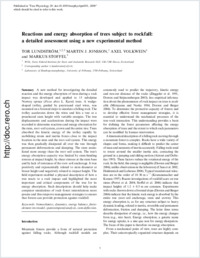Reactions and energy absorption of trees subject to rockfall: a detailed assessment using a new experimental method
- Lundström, Tor WSL, Swiss Federal Institute for Snow and Avalanche Research, Davos, Switzerland - Laboratory of Dendrogeomorphology, University of Fribourg, Switzerland
- Jonsson, Martin J. WSL, Swiss Federal Institute for Snow and Avalanche Research, Davos, Switzerland
- Volkwein, Axel WSL, Swiss Federal Institute for Snow and Avalanche Research, Davos, Switzerland
- Stoffel, Markus Laboratory of Dendrogeomorphology, University of Fribourg, Switzerland
-
23.12.2008
Published in:
- Tree Physiology. - 2009, vol. 29, no. 3, p. 345-359
biomechanics
dynamics
energy balance
finite-element tree model
spatiotemporal analysis
stem deflection
English
A new method for investigating the detailed reaction and the energy absorption of trees during a rock impact was developed and applied to 15 subalpine Norway spruce (Picea abies L. Karst) trees. A wedge-shaped trolley, guided by prestressed steel wires, was mounted on a forested slope to simulate a falling rock. The trolley accelerates down the wires and hits a tree at a preselected stem height with variable energies. The tree displacements and accelerations during the impact were recorded to determine reactions and energy absorption for the stem, root–soil system, crown and the entire tree. Trees absorbed the kinetic energy of the trolley rapidly by mobilizing strain and inertia forces close to the impact location in the stem and the root–soil system. This energy was then gradually dissipated all over the tree through permanent deformations and damping. The stem assimilated more energy than the root–soil system. The tree’s energy absorption capacity was limited by stem-bending stresses at impact height, by shear stresses at the stem base and by lack of resistance of the root–soil anchorage. It was positively and exponentially related to stem diameter at breast height and negatively related to impact height. The field experiment enabled a physical description of how a tree reacts to a rock impact and highlighted the most important and critical components of the tree for its energy absorption. Such descriptions should help make computer simulations of rock–forest interrelations more precise and thus improve management strategies to ensure that forests can provide protection against rockfall.
- Faculty
- Faculté des sciences et de médecine
- Department
- Département de Géosciences
- Language
-
- English
- Classification
- Biological sciences
- License
- License undefined
- Identifiers
-
- RERO DOC 11297
- DOI 10.1093/treephys/tpn030
- Persistent URL
- https://folia.unifr.ch/unifr/documents/300818
Statistics
Document views: 93
File downloads:
- stoffel_rea.pdf: 163
